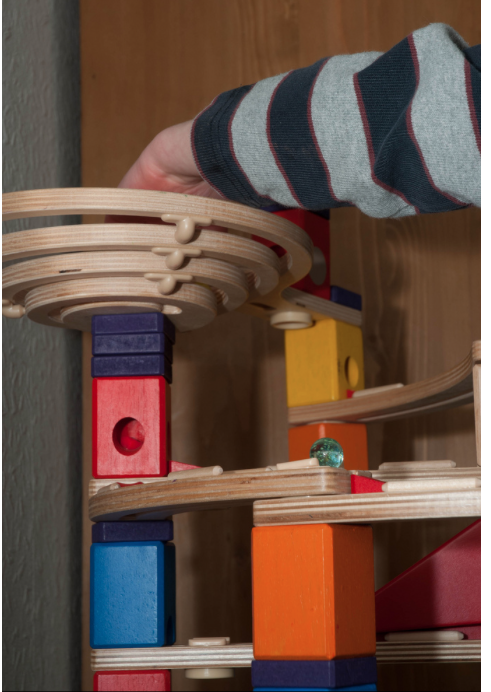
Marble Run

Overview
Creating a marble run is fun for all ages. For those who are younger, they are learning the basics of engineering design. As students get older and learn more about physics, the designs will get more elaborate.
Marble runs can be made out of anything which makes it a great repurposing activity for students to create the best run they can with materials at hand.
This STEAM activity card will take a couple of class periods depending on which activities the teacher decides to use with the students.
Learning Objectives
Students will:
- Understand simple physics.
- Be able to create a marble run.
- Be able to test theories on whether or not the run will work.
- Be able to test theories on which run will be the fastest.
- Be able to test theories on if the run will be exactly one minute or the time teacher decides on.
Vocabulary
Vocabulary Words:
- Scientific Theory: Scientific theory is based on careful examination of facts.
- Physics: Physics is the scientific study of forces such as heat, light, sound, pressure, and gravity.
- Test: To test is to try out something.
Pre-planning
To prepare for this lesson:
-
Watch the Marble run video with ideas.
-
Here is an example of one that a student created.
-
Play the computerized Marble run game.
-
Collect materials for the students to use and have them collect materials as well. Purchase or collect marbles for the runs.
-
Keva Planks can be used for the Marble Run. Read about them in the 21Things Keva Planks Task Card.
-
Look at the Pinterest ideas for Marble runs.
Accommodations
See the Accommodations Page and Charts on the 21things4students website in the Teacher Resources.
Steps
Directions for this activity:
- The teacher will explain the concept of physics and gravity to the students.
- The students will play the Marble Run game on the computer learning how to build with different bricks.
Note: The activity could end here, with the students only playing the online game. You can also extend the activity so that your students create their own Marble Run with repurposed materials.
- Students will work in small groups and brainstorm their marble run design. Have the students draw the design first on paper.
- The run should be designed so that the marble falls appropriately beginning to end.
- Depending on the level of students you have in your classroom, the design could be such that the marble has to reach the destination in one minute no more no less.
- Show the students this student video. There are many examples on YouTube.
- Students will take their collected materials and build their design.
- Students will test their designs.
- Students will test each other's designs.
Assessment Options
Different options for assessing the students:
- Observations
- Check for understanding
- Create a rubric that matches the objectives.(e.g. works in exactly one minute, falls appropriately, creativity)
MITECS Competencies & ISTE STANDARDS
MITECS: Michigan adopted the "ISTE Standards for Students" called MITECS (Michigan Integrated Technology Competencies for Students) in 2018.
Innovative Designer
4a. Students know and use a deliberate design process for generating ideas, testing theories, creating innovative artifacts or solving authentic problems.
4c. Students develop, test and refine prototypes as part of a cyclical design process.
4d. Students exhibit a tolerance for ambiguity, perseverance and the capacity to work with open-ended problems.
Devices and Resources
Device: PC, Chromebook, Mac, iPad (
Browser: Chrome, Safari, Firefox, Edge, ALL
Website:
Homemade Marble Run
Marble Run Game
CONTENT AREA RESOURCES
Integrated Arts
Creating the marble run is artistic and adds art to STEM.
Math
-
Students can learn how to use timers to time the runs.
Science
- This activity can be used when teaching gravity.
- This activity can be used to teach basic engineering and physics.
CREDITS
This task card was created by Melissa White, 21Things Project Manager, REMC Association of Michigan, February 2018. Updated October 2023.


